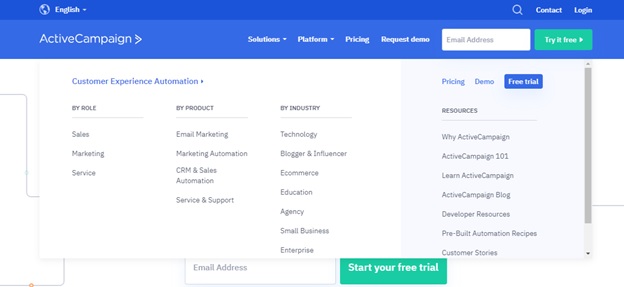There are thousands upon thousands of startups being launched every year. A select few of them are singled out and funded by Angels and VCs but that’s no guarantee of success. It only increases your chances or staves off the inevitable failure. So how do you gain startup traction to set yourself up to be one of the few companies that stands the test of time? There’s no sure-fire formula that will ensure you don’t fail but there are many things you can do to give yourself a fighting chance.
This guide looks at multiple strategies you can use together to level the playing field and get to initial traction.
Analyze the competitive landscape
The first step is to take a deep dive into the marketing strategies of your competitors. When you know where to look, this is a simple process.
Start by visiting their website to understand the messaging they’re using and the audience they’re targeting. Sometimes it’ll be obvious like “website builder for realtors” and at other times it will be more difficult to guess the target audience because they use language like “best website builder online.” There are even times when they’re targeting multiple market segments.
 In the image above, ActiveCampaign creates individual pages for each of the markets it’s going after. It’s a mature platform so it has the resources and feature set to pull it off. When you’re starting off, you likely won’t have either.
In the image above, ActiveCampaign creates individual pages for each of the markets it’s going after. It’s a mature platform so it has the resources and feature set to pull it off. When you’re starting off, you likely won’t have either.
After you’ve gone through their websites and noted down the important elements of their messaging, visit popular social media platforms. Are they retargeting you there? If so, what kind of messaging are they using, and which landing pages do the ads send you to? Make a note.
After you’ve done the preliminary research, register for a tool like SemRush or Ahrefs to get data about their SEO initiatives. Are they actively building links, do they have PPC campaigns set up, what keywords are they targeting, etc.?
Repeat this process with each of your major competitors and look for any gaps in their marketing mix that you can exploit.
We went through this process when we were trying to build out the initial marketing plan for UsefulPDF. We realized that everyone had similar messaging, similar websites, and optimized heavily for SEO.
There was a reason for this. The brands relied on display advertising for a large portion of their revenue and the tools are free for most users. Only a small percentage of people ever became customers so a PPC campaign would likely be too expensive.
Do systematic testing
After the initial audit of your competitors, choose the marketing channels you’d like to try first. Ideally, these are strategies that don’t take too long to yield fruit. You’ll know whether it’s working or not within a few days or weeks. This will allow you to get to initial traction even faster.
Even though you’re going to be moving fast, that doesn’t mean you’ll do this in a haphazard manner. The common wisdom is to throw spaghetti at the wall and see what sticks. That’s a recipe for losing a lot of money.
You started with an initial competitive audit to prevent that from happening. Systematic testing requires you to create a hypothesis and test it to see if it’s true.
For each marketing channel you’ve chosen, create multiple small-scale tests for customer acquisition. For example, if you settled on Google PPC, you’d create three hypotheses such as:
- If we bid on the term ‘professionals’ and set up an ad that mentions our email marketing tool for professionals, then we’ll get a 2% CTR and a 3% free trial conversion rate.
- If we bid on the term ‘email marketing and set up an ad that mentions our email marketing tool for professionals, then we’ll get a 1% CTR and a 2% free trial conversion rate.
- If we bid on the term ‘consultants’ and set up an ad that mentions our email marketing tool for professionals, then we’ll get a 4% CTR and a 4% free trial conversion rate
After setting up and running each test, analyze the results. Are you profitable? If not, can you make a few tweaks with the data you gained to get profitable? Are you learning anything new about your target audience?
If you invalidate the first strategy you try, move on to the next one. Keep going until you find one that gets you customers at an acceptable CAC. When one works out then continue to tweak the campaigns to lower the cost of acquisition.
Incentivize referrals
While doing systematic testing, you should start acquiring customers regularly. Pour more fuel on the fire you’ve started by encouraging word of mouth. You can do this in a number of ways but it ultimately depends on your business.
For example, PayPal incentivized users to bring more users by offering a $20 credit to the accounts of both people. It accelerated the user acquisition produced from other channels. A cash credit made sense for PayPal but not all companies need to offer money as an incentive.
Dropbox gave users more storage space for every new user they referred to the platform. It worked so well that the company had an IPO and is worth billions of dollars today.
Think about what you can offer current customers that bring in new customers:
- Access to pro features for a limited amount of time
- Extra credits
- More of your value metric (the thing that you charge for)
- Access to a partner network
- Discounts on their plan
- Etc.
I recommend testing different incentives and see which one produces the greatest viral coefficient. After you find it, gain traction by continuing to tweak the specific offer so it brings in even more results. In the end, each new customer should contribute towards bringing in another customer.
Delight your first customers
While incentivized referrals are powerful, the best referrals are those that happen naturally. Your customers are so happy with your service that they tell other people about it. This is a simple social phenomenon. People want to be viewed positively by their social circle so they recommend good tools and warn others about bad ones.
If you’re able to delight your customers from day one, they’ll be much more likely to recommend your brand. There are a number of ways to delight customers:
- Superior customer support
- A better product
- A great UI
- A thoughtful onboarding process
- Generous policies around returns or something your customers would appreciate
Again, how you delight your customers depends on your business. Brainstorm ideas that make the most sense for you and implement them as quickly as possible. Just like with incentivized referrals, the people that come through this route will stay longer and spend more with your organization.
Conclusion
There are countless ways to get to initial traction. You may take an unconventional approach, ignore everything in this article, and achieve greatness. For the rest of us, these insights will serve well.
I encourage you to focus on what makes the most sense for you and ignore the rest. Over time, you’ll see the fruits reflected in the growth of your company.
Felix Yim is the founder of Society of Speed, an automotive journal covering the unique lifestyle of supercar owners. Alongside automotive journalism, Felix recently graduated from university with a finance degree and enjoys helping students and other young founders grow their projects.
Startup traction stock photo by Khakimullin Aleksandr/Shutterstock







